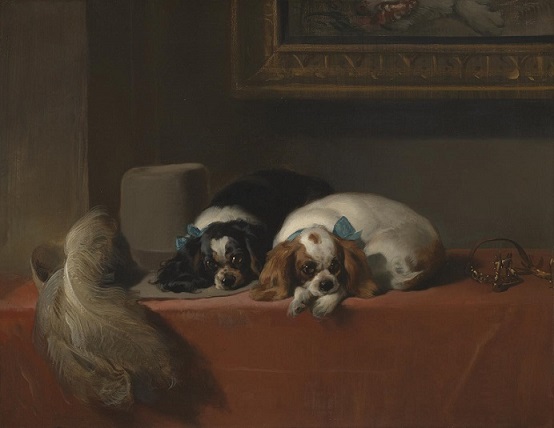History
Cavalier King Charles originated in East Asia arrived in Europe in the 1500s. They have long been linked with British royalty. Indeed, they received their namesake after King Charles II of Great Britain and Ireland who made the breed popular along with other royal family members over the centuries.
Early versions of the breed were gifted to European royalty by Japanese diplomats. It is thought that they likely share a common ancestor with the Pekingese and Japanese Chin dog. From these dogs that arrived from Asia, several modern breeds were formed including the Cavalier King Charles and the stouter, shorter-nosed King Charles Spaniel.
The Cavalier King Charles Spaniel is named after King Charles, who reigned in England from 1660 to 1685. It is said that he loved his spaniels so much that two or three of them would accompany him almost anywhere. This led to him decreeing that the breed can be allowed in any public space, including the House of Parliament. Although this decree still exists, it has yet to be tested in recent times.

During the early part of the 18th century, the Duke of Marlborough received as a gift from China a pair of red and white Cocker Spaniels, dogs that would be the foundation of his subsequent breedings (and the predecessors to the Cavalier and English Toy). Over time, the dogs would be crossed with Cockers and Springers which intensified sporting instincts still seen in those breeds today. The dukes of Marlborough bred these red and white dogs for generations in their residence Blenheim Palace. Because of this influence, the red and white variety of the King Charles Spaniel and Cavalier King Charles Spaniel became known as the Blenheim. These dogs often have a thumb mark known as the “Blenheim Spot” that appears on the top center of the skull.

The breeds that became the modern-day Cavalier King Charles were initially used for hunting but eventually became obsolete in favor of larger breeds. Following the death of King Charles, the popularity of these Spaniels waned and in many places, the breed was altered by cross-breeding with flat-faced breeds. The long-nosed spaniels depicted in paintings from earlier centuries were almost extinct. In the early days there were no dog shows, and no recognised standard of points, so type and size were very varied. With little transport available, breeding was carried out in a haphazard fashion. In Queen Victoria’s reign breeders started to hold shows and enthusiasts began to breed dogs seriously, and to a desired type. This brought a new fashion; dogs with a shorter face gradually evolving the flat face of the modern King Charles Spaniels. There were a lot of very able breeders at that stage, and they were successful in breeding dogs of the highest quality, with flat faces, high dome, and with very long ears set low. This type is still popular and a very lovely breed.
In 1903, the Kennel Club attempted to amalgamate the King James (black and tan), Prince Charles (tricolour), Blenheim and Ruby spaniels into a single breed called the Toy Spaniel. The Toy Spaniel Club, which oversaw those separate breeds, strongly objected, and the argument was only resolved following the intervention of King Edward VII, who made it clear that he preferred the name “King Charles Spaniel”. In 1904, the American Kennel Club followed suit, combining the four breeds into a single breed known as the English Toy Spaniel.
In 1926, Mr Roswell Eldridge, an American and a great lover of Toy Spaniels, came over to England and was unpleasantly surprised to find that there were none of the little nosey spaniels left. He immediately set about trying to right this by offering prizes at Crufts for three years (it was later extended to five years) – £25 for the best dog and best bitch, for dogs of the variety seen in King Charles II’s time. The following is a quotation taken from Cruft’s catalogue: “As shown in the pictures of King Charles II’s time, long face, no stop; flat skull, not inclined to be domed and with the spot in the centre of the skull.”

The King Charles breeders did not take these classes very seriously. They had worked hard for years to do away with the long nose, so it was hardly a popular move. Gradually, as the big prizes came to an end, only a few enthusiasts were left to carry on the breeding experiment. Foremost amongst them was Mrs Hewitt Pitt. At the end of five years little had been achieved, as the Kennel Club considered that the dogs were not sufficiently numerous or standardised to merit a separate breed registration.
In 1928 a club was founded, and the title “Cavalier King Charles Spaniel” was chosen. At the first meeting, held the second day of Cruft’s Dog Show, 1928, the standard of the breed was drawn up, and it was practically the same as it is today. The live pattern on the table was Ann’s Son, the property of Miss Mostyn Walker. Members brought all the reproductions of pictures of the 16th, 17th and 18th centuries that they could muster. It was agreed that as far as possible the dog should be guarded from fashion and there was to be no trimming.

In 1945 the Kennel Club granted separate registration, and the first set of Challenge Certificates followed a year later.
Source:
The Cavalier King Charles Spaniel Club, UK
National Purebred Dog Day®, USA
American Cavalier King Charles Spaniel Club, Inc.
Jackson, Frank (1990) ‘Crufts: The Official History’, London, Pelham Books. p. 116.